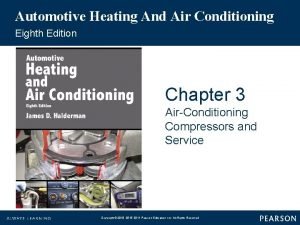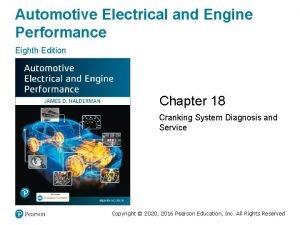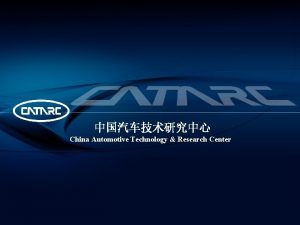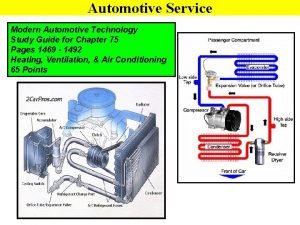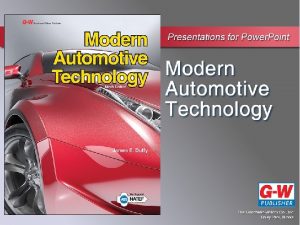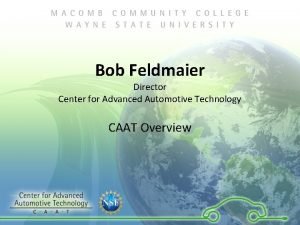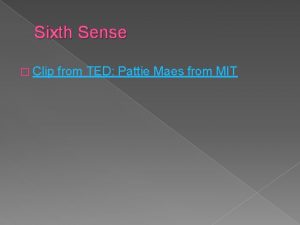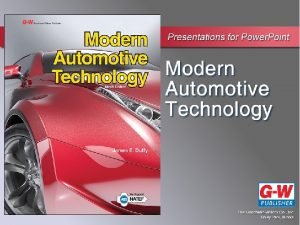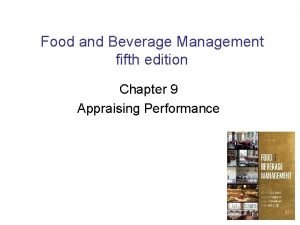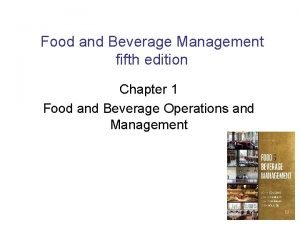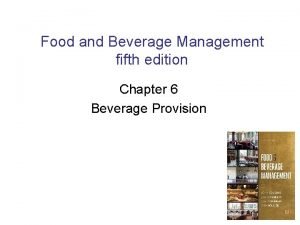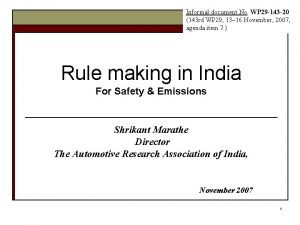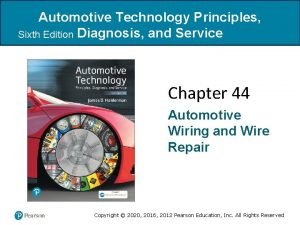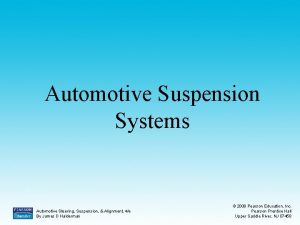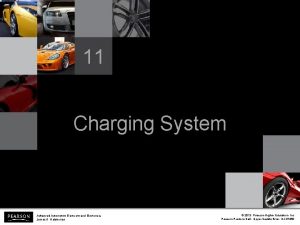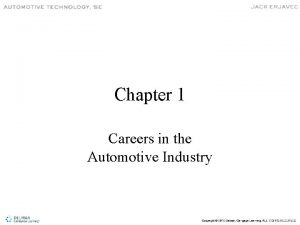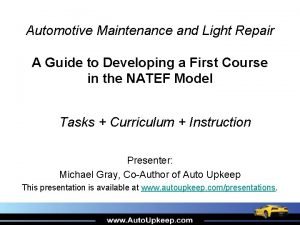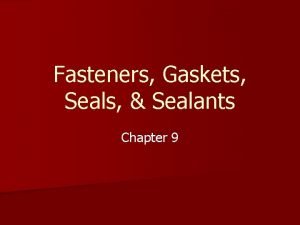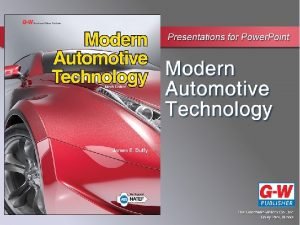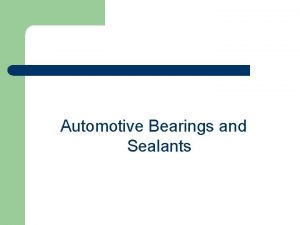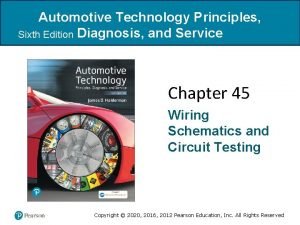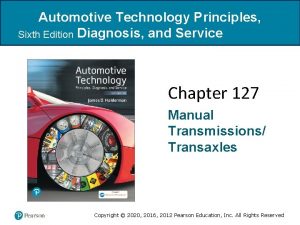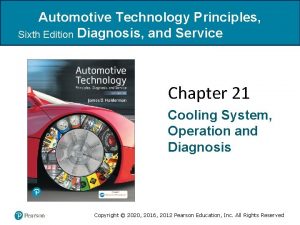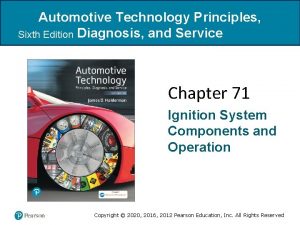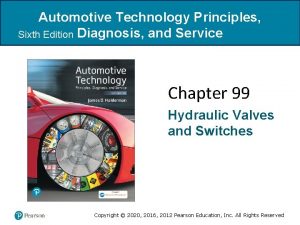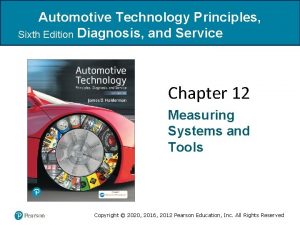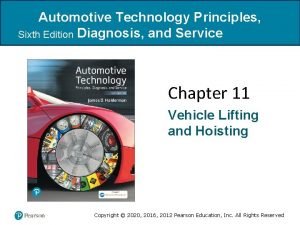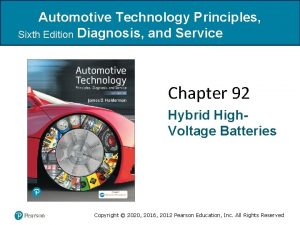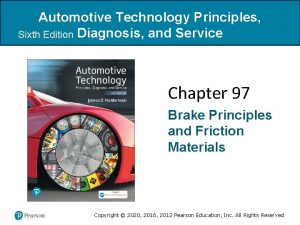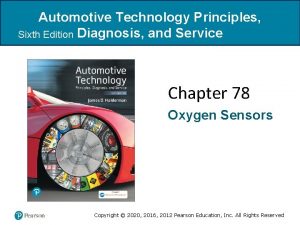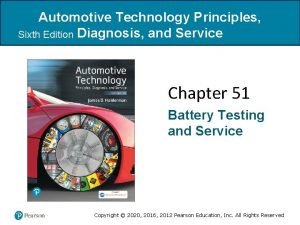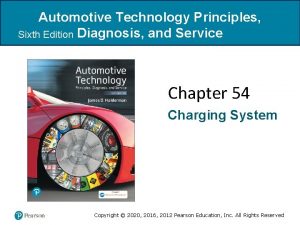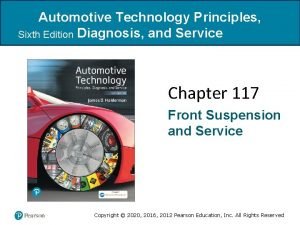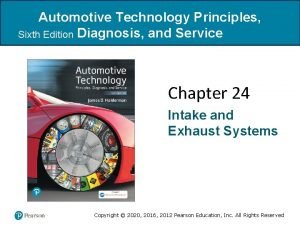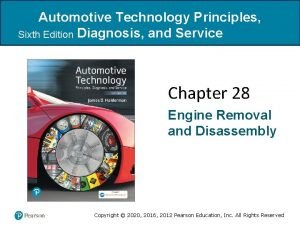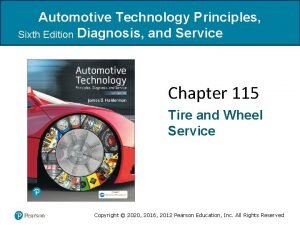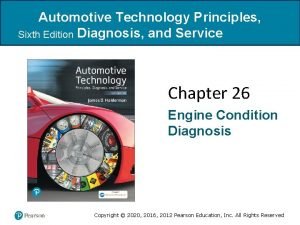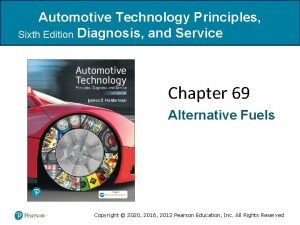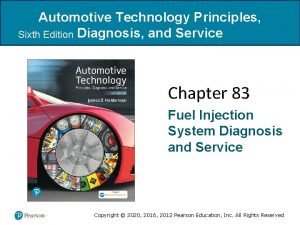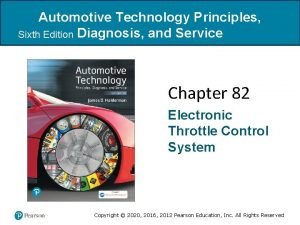Automotive Technology Principles Sixth Edition Diagnosis and Service






























































- Slides: 62

Automotive Technology Principles, Sixth Edition Diagnosis, and Service Chapter 129 Drive Shaft and CV Joint Service Copyright © 2018, 2015, 2011 Pearson Education, Inc. All Rights Reserved Copyright © 2020, 2016, 2012 Pearson Education, Inc. All Rights Reserved

LEARNING OBJECTIVES (1 of 2) 129. 1 Explain how to diagnose and inspect a Ujoint. 129. 2 List the steps necessary to replace a U-joint. 129. 3 Explain how to perform a measurement of the working angles of a U-joint. Copyright © 2020, 2016, 2012 Pearson Education, Inc. All Rights Reserved

LEARNING OBJECTIVES (2 of 2) 129. 4 Diagnose problems with CV joints and describe the service procedures for replacing CV joints. 129. 5 This chapter will help prepare for Suspension and Steering (A 4) ASE certification test content area “C” (Related Suspension and Steering Service). Copyright © 2020, 2016, 2012 Pearson Education, Inc. All Rights Reserved

U-JOINT DIAGNOSIS • Symptoms of a Defective U-Joint – Vibration or harshness at highway speed – A clicking sound whenever the vehicle is moving either forward or in reverse – A clunking sound whenever changing gears, such as moving from drive to reverse Copyright © 2020, 2016, 2012 Pearson Education, Inc. All Rights Reserved

CASE STUDY Copyright © 2020, 2016, 2012 Pearson Education, Inc. All Rights Reserved

Figure 129. 1 Notice how the needle bearings have worn grooves, called Brinelling, into the bearing surface of the U-joint Copyright © 2020, 2016, 2012 Pearson Education, Inc. All Rights Reserved

QUESTION 1: ? What are the symptoms of a defective u-joint? Copyright © 2020, 2016, 2012 Pearson Education, Inc. All Rights Reserved

ANSWER 1: A vibration, a clicking noise or a clunking noise. Copyright © 2020, 2016, 2012 Pearson Education, Inc. All Rights Reserved

DRIVE SHAFT AND U-JOINT INSPECTION • The driveshaft should be inspected for the following: – – Any dents or creases caused by impact Undercoating, grease, or dirt buildup on the driveshaft Any movement of the U-joints To inspect U-joints, move each joint through its full travel Copyright © 2020, 2016, 2012 Pearson Education, Inc. All Rights Reserved

Figure 129. 2 All U-joints and spline collars equipped with a grease fitting should be greased four times a year as part of a regular lubrication service Copyright © 2020, 2016, 2012 Pearson Education, Inc. All Rights Reserved

Figure 129. 3 Many U-joints require a special grease gun tool to reach the grease fittings Copyright © 2020, 2016, 2012 Pearson Education, Inc. All Rights Reserved

Figure 129. 4 Always mark the original location of Ujoints before disassembly Copyright © 2020, 2016, 2012 Pearson Education, Inc. All Rights Reserved

Figure 129. 5 Two types of retaining methods that are commonly used at the rear U-joint at the differential Copyright © 2020, 2016, 2012 Pearson Education, Inc. All Rights Reserved

Figure 129. 6 The best way to check any U joint is to remove the driveshaft from the vehicle and move each joint in all directions. A good U-joint should be free to move without binding Copyright © 2020, 2016, 2012 Pearson Education, Inc. All Rights Reserved

U-JOINT REPLACEMENT • Three types of retainers are used to keep the bearing caps on the U-joints: the outside snap ring, the inside retaining ring, and injected synthetic (usually nylon). • After removing the retainers, use a press or a vise to separate the U-joint from the yoke. • After removing any dirt or burrs from the yoke, press in a new U-joint. • Rotate the new joint after installation to make sure it moves freely, without binding or stiffness. Copyright © 2020, 2016, 2012 Pearson Education, Inc. All Rights Reserved

Figure 129. 7 Typical U-joint that uses an outside snap ring. This style of joint bolts directly to the companion flange that is attached to the pinion gear in the differential Copyright © 2020, 2016, 2012 Pearson Education, Inc. All Rights Reserved

Figure 129. 8 A U-joint that is held together by nylon and usually requires that heat be applied to remove from the yoke Copyright © 2020, 2016, 2012 Pearson Education, Inc. All Rights Reserved

Figure 129. 9 Use a vise and two sockets to remove a U-joint. One socket fits over the bearing cup and the other fits on the bearing to press-fit the cups from the crosspiece Copyright © 2020, 2016, 2012 Pearson Education, Inc. All Rights Reserved

TECH TIP Copyright © 2020, 2016, 2012 Pearson Education, Inc. All Rights Reserved

Figure 129. 10 Taping the U-joint to prevent the caps from coming off Copyright © 2020, 2016, 2012 Pearson Education, Inc. All Rights Reserved

Figure 129. 11 A special tool being used to press apart a U-joint that is retained by injected plastic. Heat from a propane torch may be necessary to soften the plastic to avoid exerting too much force on the U-joint Copyright © 2020, 2016, 2012 Pearson Education, Inc. All Rights Reserved

Figure 129. 12 Removing the worn cross from the yoke Copyright © 2020, 2016, 2012 Pearson Education, Inc. All Rights Reserved

Figure 129. 13 When installing a new U-joint, position the grease fitting on the inboard side (toward the driveshaft tube) and in alignment with the grease fitting of the U-joint at the other end Copyright © 2020, 2016, 2012 Pearson Education, Inc. All Rights Reserved

U-JOINT WORKING ANGLES • Unequal or incorrect U-joint working angles can cause severe vibrations. Driveshaft and U-joint angles may change from the original factory setting due to one or more of the following: – Defective or collapsed engine or transmission mounts – Defective or sagging springs, especially the rear springs due to overloading or other causes – Accident damage or other changes to the chassis of the vehicle – Vehicle modification that raises or lowers the ride height Copyright © 2020, 2016, 2012 Pearson Education, Inc. All Rights Reserved

Figure 129. 14 The working angle of most U-joints should be at least 1/2 degree (to permit the needle bearing to rotate in the U-joints) and should not exceed 3 degrees or a vibration can occur in the driveshaft, especially at higher speeds. The difference between the front and rear working angles should be within 1/2 degree of each other Copyright © 2020, 2016, 2012 Pearson Education, Inc. All Rights Reserved

Figure 129. 15 An inclinometer with a magnetic base is being used to measure the angle of the driveshaft at the rear U joint Copyright © 2020, 2016, 2012 Pearson Education, Inc. All Rights Reserved

Figure 129. 16 Placing a tapered metal wedge between the rear leaf spring and the rear axle pedestal to correct rear U-joint working angles Copyright © 2020, 2016, 2012 Pearson Education, Inc. All Rights Reserved

Figure 129. 17 A transmission oil pan gasket leak allowed automatic transmission fluid (ATF) to saturate the rear transmission mount rubber, causing it to collapse. After replacing the defective mount, proper driveshaft angles were restored and the driveline vibration was corrected Copyright © 2020, 2016, 2012 Pearson Education, Inc. All Rights Reserved

QUESTION 2: ? What is the allowable difference in working angles between the front and rear u-joint? Copyright © 2020, 2016, 2012 Pearson Education, Inc. All Rights Reserved

ANSWER 2: ½ degree. Copyright © 2020, 2016, 2012 Pearson Education, Inc. All Rights Reserved

CV JOINT DIAGNOSIS • When a CV joint wears or fails, the most common symptom is noise while driving. • An outer fixed CV joint will most likely be heard when turning sharply and accelerating at the same time. • This noise is usually a clicking sound. Copyright © 2020, 2016, 2012 Pearson Education, Inc. All Rights Reserved

REPLACEMENT SHAFT ASSEMBLIES • In many places the standard repair procedure is the replacement of the entire drive assembly if there is a CV joint failure. • It is felt that even a slight amount of dirt or water inside a CV joint is unacceptable. Copyright © 2020, 2016, 2012 Pearson Education, Inc. All Rights Reserved

CV JOINT SERVICE • Remove the front wheel and hub nut. • Disconnect the knuckle to allow enough room to move outward enough to remove the drive axle shaft. • Remove the axle from the hub bearing. • Remove the inner joint from the transaxle. • Disassemble, clean and inspect all components. • Replace the entire joint if there any worn parts. • Reinstall the drive axle shaft in the reverse order of removal. Copyright © 2020, 2016, 2012 Pearson Education, Inc. All Rights Reserved

Figure 129. 18 The hub nut must be removed before the hub bearing assembly or drive axle shaft can be removed from the vehicle Copyright © 2020, 2016, 2012 Pearson Education, Inc. All Rights Reserved

Figure 129. 19 Many knuckles are attached to the ball joint on the lower control arm by a pinch bolt Copyright © 2020, 2016, 2012 Pearson Education, Inc. All Rights Reserved

Figure 129. 20 The preferred method for separating the tie rod end from the steering knuckle is to use a puller such as the one shown. A “pickle-fork”-type tool should be used only if the tie rod is going to be replaced. Copyright © 2020, 2016, 2012 Pearson Education, Inc. All Rights Reserved

Figure 129. 21 Many drive axles are retained by prevailing torque nut that must not be reused. Prevailing torque nuts are slightly deformed or contain a plastic insert that holds the nut tight (retains the torque) to the shaft without loosening Copyright © 2020, 2016, 2012 Pearson Education, Inc. All Rights Reserved

Figure 129. 22 A special General Motors tool is being used to separate the drive axle shaft from the wheel hub bearing Copyright © 2020, 2016, 2012 Pearson Education, Inc. All Rights Reserved

Figure 129. 23 Most inner CV joints can be separated from the transaxle with a prybar Copyright © 2020, 2016, 2012 Pearson Education, Inc. All Rights Reserved

Figure 129. 24 When removing a drive axle shaft assembly, use care to avoid pulling the plunge joint apart Copyright © 2020, 2016, 2012 Pearson Education, Inc. All Rights Reserved

Figure 129. 25 If other service work requires that just one end of the drive axle shaft be disconnected from the vehicle, be sure that the free end is supported to prevent damage to the protective boots or allowing the joint to separate Copyright © 2020, 2016, 2012 Pearson Education, Inc. All Rights Reserved

Figure 129. 26 With a scribe, mark the location of the boots before removal. The replacement boots must be in the same location Copyright © 2020, 2016, 2012 Pearson Education, Inc. All Rights Reserved

Figure 129. 27 Most CV joints use a snap ring to retain the joint on the drive axle shaft Copyright © 2020, 2016, 2012 Pearson Education, Inc. All Rights Reserved

Figure 129. 28 After releasing the snap ring, most CV joints can be tapped off the shaft using a brass or shotfilled plastic (dead blow) hammer Copyright © 2020, 2016, 2012 Pearson Education, Inc. All Rights Reserved

Figure 129. 29 Typical outer CV joint after removing the boot and the joint from the drive axle shaft. This joint was removed from the vehicle because a torn boot was found. After disassembly and cleaning, this joint was found to be OK and was put back into service. Copyright © 2020, 2016, 2012 Pearson Education, Inc. All Rights Reserved

Figure 129. 31 Be sure to use all of the grease supplied with the replacement joint or boot kit. Use only the grease supplied and do not use substitute grease Copyright © 2020, 2016, 2012 Pearson Education, Inc. All Rights Reserved

Figure 129. 32 A punch being used to keep the rotor from rotating while torqueing the axle shaft spindle nut Copyright © 2020, 2016, 2012 Pearson Education, Inc. All Rights Reserved

QUESTION 3: ? What is a symptom of a defective outer CV joint? Copyright © 2020, 2016, 2012 Pearson Education, Inc. All Rights Reserved

ANSWER 3: A clicking noise on turns. Copyright © 2020, 2016, 2012 Pearson Education, Inc. All Rights Reserved

CASE STUDY Copyright © 2020, 2016, 2012 Pearson Education, Inc. All Rights Reserved

Figure 129. 33 The engine had to be raised higher to get the new (non-collapsed) engine mount installed Copyright © 2020, 2016, 2012 Pearson Education, Inc. All Rights Reserved

Drive Axle Shaft Replacement Copyright © 2020, 2016, 2012 Pearson Education, Inc. All Rights Reserved

1 Tools needed to replace a drive axle shaft on a General Motors vehicle include a drift, sockets, plus a prybar bearing/axle shaft special tool. Copyright © 2020, 2016, 2012 Pearson Education, Inc. All Rights Reserved

2 The drive axle shaft retaining nut can be loosened with the tire on the ground, or use a drift inserted into the rotor cooling fins before removing the nut. Copyright © 2020, 2016, 2012 Pearson Education, Inc. All Rights Reserved

3 Using a special tool to push the drive axle splines from the bearing assembly. Copyright © 2020, 2016, 2012 Pearson Education, Inc. All Rights Reserved

4 Remove the disc brake caliper and support it out of the way. Then, remove the disc brake rotor. Copyright © 2020, 2016, 2012 Pearson Education, Inc. All Rights Reserved

5 The lower ball joint could have been removed instead of disconnecting the strut from the knuckle so that the alignment could be retained. Copyright © 2020, 2016, 2012 Pearson Education, Inc. All Rights Reserved

6 A prybar is used to separate the inner drive axle shaft joint from the transaxle. Copyright © 2020, 2016, 2012 Pearson Education, Inc. All Rights Reserved

7 After the inner joint splines have been released from the transaxle, carefully remove the drive axle shaft assembly from the vehicle. Copyright © 2020, 2016, 2012 Pearson Education, Inc. All Rights Reserved

8 To install, reverse the disassembly procedure and be sure to install the washer under the retainer-nut, and always use a new prevailing torque nut. Copyright © 2020, 2016, 2012 Pearson Education, Inc. All Rights Reserved

9 Reinstall the disc brake rotor and caliper and then torque the drive axle shaft retaining nut to factory specifications. Copyright © 2020, 2016, 2012 Pearson Education, Inc. All Rights Reserved

Copyright © 2020, 2016, 2012 Pearson Education, Inc. All Rights Reserved
 Automotive technology sixth edition
Automotive technology sixth edition Automotive technology sixth edition
Automotive technology sixth edition Principles of economics sixth edition
Principles of economics sixth edition The sixth sheik's sixth sheep's sick
The sixth sheik's sixth sheep's sick Rubber baby buggy bumpers tongue twister lyrics
Rubber baby buggy bumpers tongue twister lyrics Automotive heating and air conditioning 8th edition
Automotive heating and air conditioning 8th edition Biochemistry sixth edition 2007 w.h. freeman and company
Biochemistry sixth edition 2007 w.h. freeman and company Automotive engines 8th edition
Automotive engines 8th edition China automotive technology and research center
China automotive technology and research center Computer architecture a quantitative approach sixth edition
Computer architecture a quantitative approach sixth edition Citation sample pdf
Citation sample pdf Computer architecture a quantitative approach 6th
Computer architecture a quantitative approach 6th Precalculus sixth edition
Precalculus sixth edition Computer architecture a quantitative approach sixth edition
Computer architecture a quantitative approach sixth edition Steps of nursing process
Steps of nursing process Medical diagnosis and nursing diagnosis difference
Medical diagnosis and nursing diagnosis difference Medical diagnosis and nursing diagnosis difference
Medical diagnosis and nursing diagnosis difference Objectives of nursing process
Objectives of nursing process Modern automotive technology answer key
Modern automotive technology answer key Emission control system components
Emission control system components Mechanical technology automotive grade 11
Mechanical technology automotive grade 11 Center for advanced automotive technology
Center for advanced automotive technology Rivet split pin
Rivet split pin Sixth sense technology seminar report
Sixth sense technology seminar report Sixth sense technology seminar
Sixth sense technology seminar Sixth sense ted
Sixth sense ted Perbedaan diagnosis gizi dan diagnosis medis
Perbedaan diagnosis gizi dan diagnosis medis Chapter 81 brake system technology answers
Chapter 81 brake system technology answers Using mis 10th edition
Using mis 10th edition Mis
Mis Computer security principles and practice
Computer security principles and practice Computer security principles and practice 4th edition
Computer security principles and practice 4th edition Expert systems: principles and programming, fourth edition
Expert systems: principles and programming, fourth edition Kasavana and smith matrix
Kasavana and smith matrix Food and beverage service' 9 th edition
Food and beverage service' 9 th edition Food service cycle
Food service cycle Food and beverage service' 9 th edition
Food and beverage service' 9 th edition Food and beverage service methods
Food and beverage service methods Food and beverage service' 9 th edition
Food and beverage service' 9 th edition Information technology project management 9th edition
Information technology project management 9th edition Information technology project management 9th edition ppt
Information technology project management 9th edition ppt Ethics in information technology fourth edition
Ethics in information technology fourth edition Ethics in information technology fourth edition
Ethics in information technology fourth edition Project management quality control
Project management quality control Information technology project management 9th edition
Information technology project management 9th edition Basic environmental technology 6th edition pdf
Basic environmental technology 6th edition pdf Information technology project management 9th edition
Information technology project management 9th edition Automotive regulations and standards
Automotive regulations and standards Chapter 44 automotive wiring and wire repair
Chapter 44 automotive wiring and wire repair 4e alignment
4e alignment Advanced automotive electronics
Advanced automotive electronics Chapter 2 automotive careers and ase certification
Chapter 2 automotive careers and ase certification Auto upkeep answer key
Auto upkeep answer key Fasteners gaskets seals and sealants
Fasteners gaskets seals and sealants Chapter 8 fasteners gaskets seals and sealants
Chapter 8 fasteners gaskets seals and sealants Automotive bearings and seals
Automotive bearings and seals Principles of information security 5th edition pdf
Principles of information security 5th edition pdf Principles of electronic communication systems 3rd edition
Principles of electronic communication systems 3rd edition Principles of economics oxford fajar pdf
Principles of economics oxford fajar pdf Accounting principles second canadian edition
Accounting principles second canadian edition Accounting principles second canadian edition
Accounting principles second canadian edition Accounting principles second canadian edition
Accounting principles second canadian edition Management robbins coulter
Management robbins coulter





